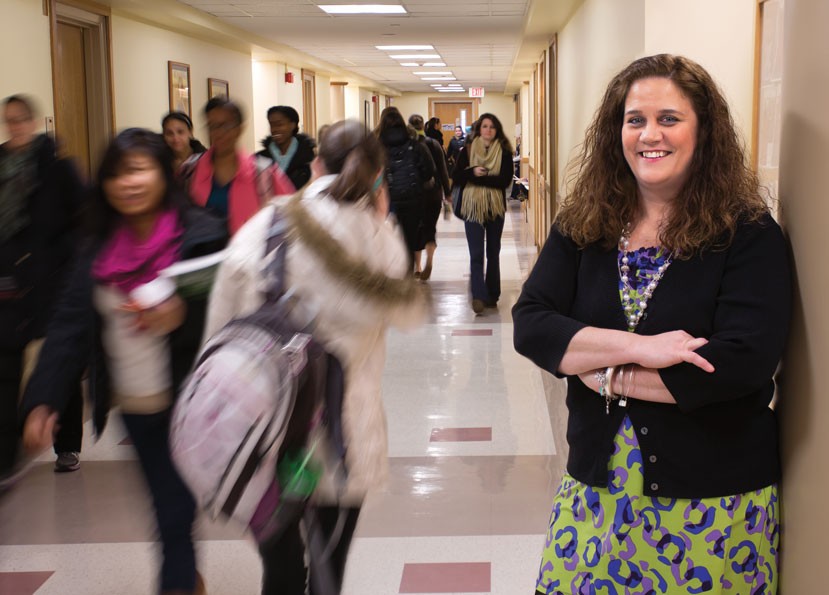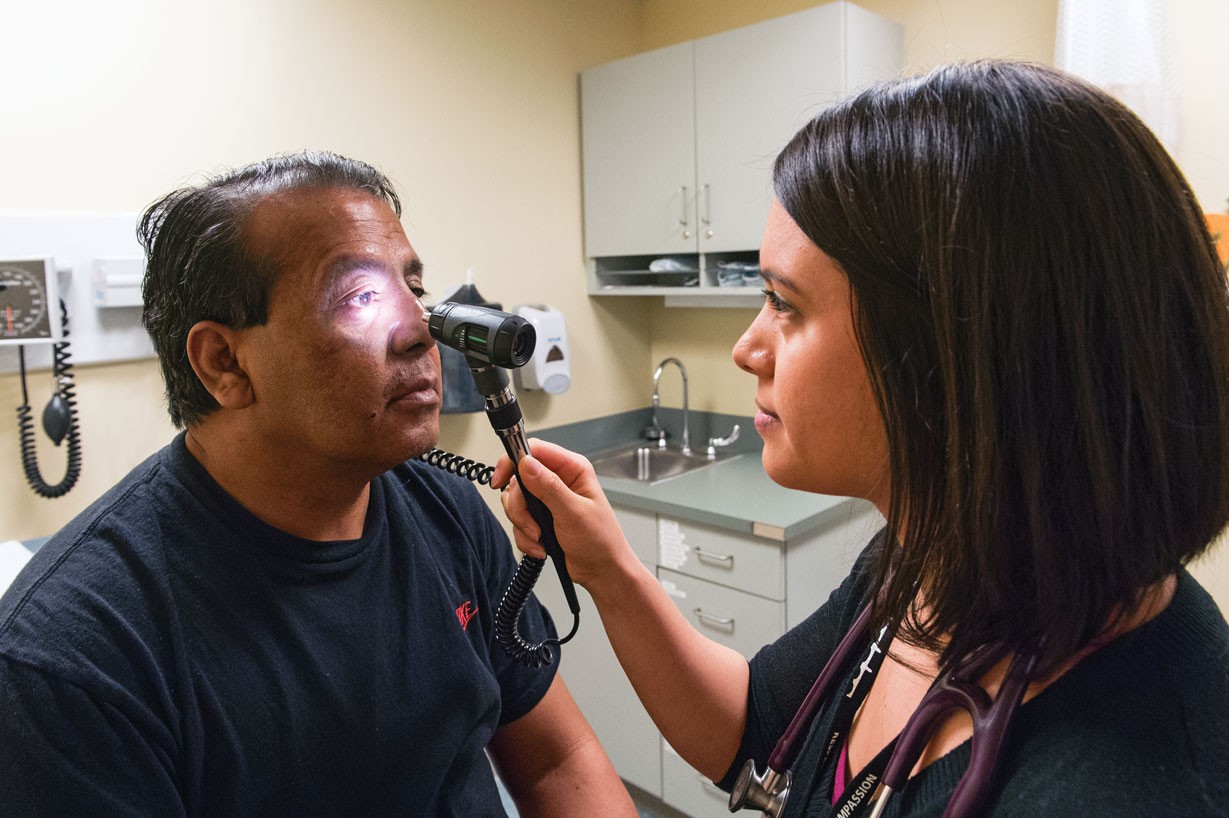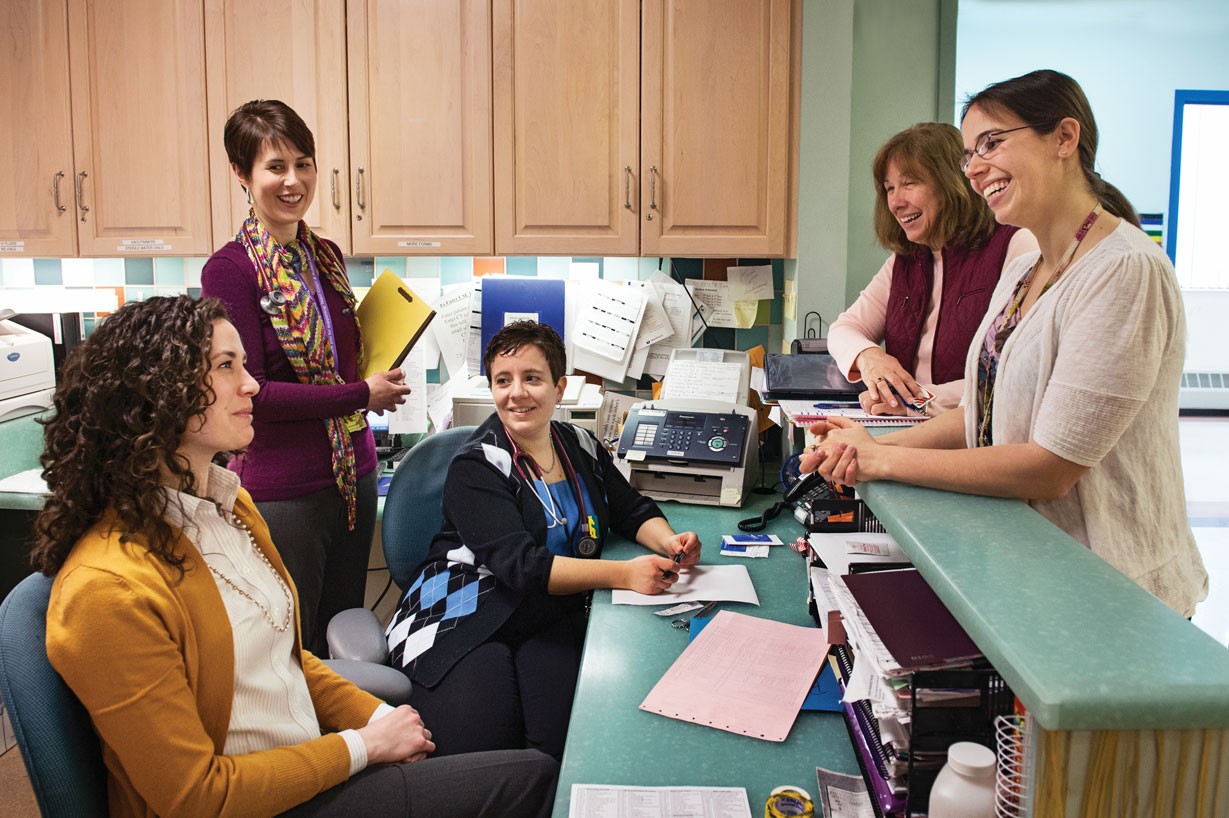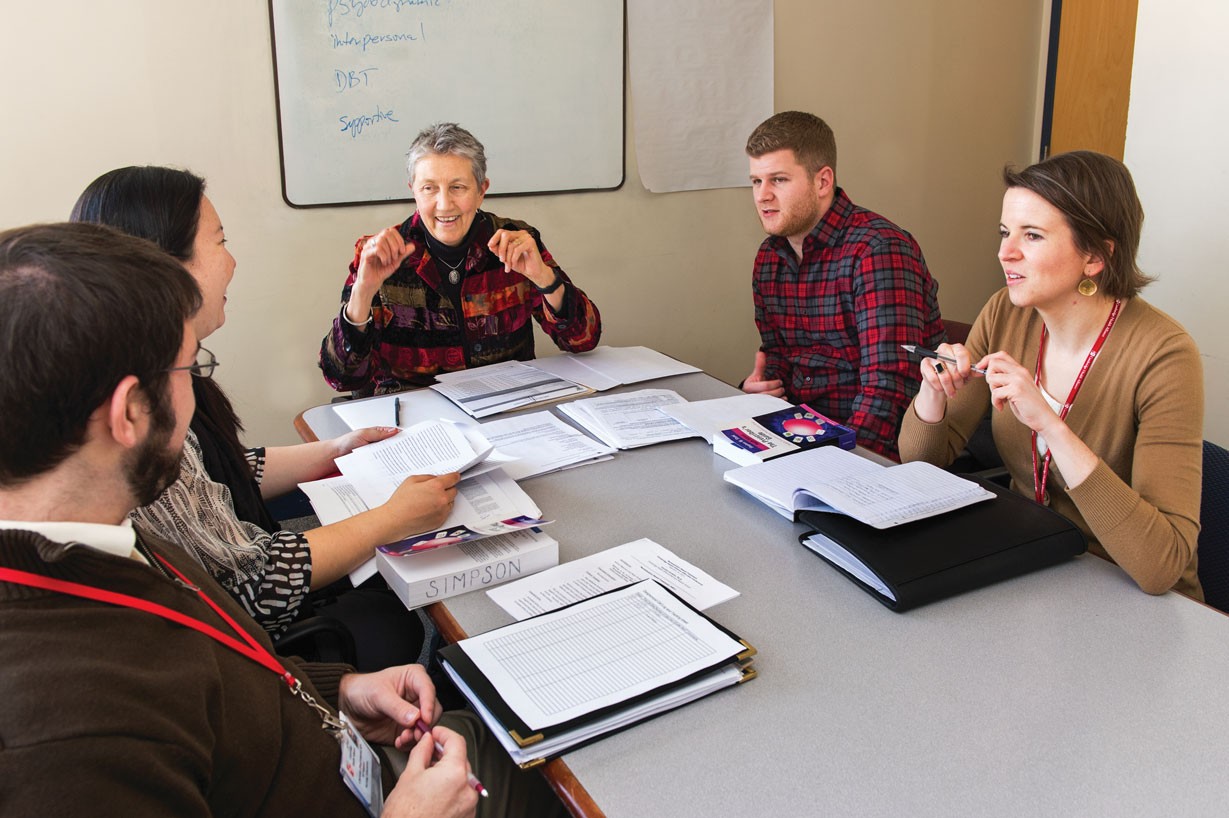
Associate Professor Jane Flanagan pairs preceptors and students.
It’s a December morning at Harvard Vanguard Medical Associates in Somerville, and Maureen Gehlenborg, M.S. ’13, is giving a pregnant woman an ultrasound. “You have a busy baby!” she tells her. Cynthia Tefft, M.S. ’82, looks up from her notes and agrees. “Have you been seeing a lot of movement?” she asks. The woman laughs and relays her toddler son’s amazement at how much the baby kicks.
Tefft takes the lead for the rest of the appointment, gently interviewing the woman about her birth plan, while Gehlenborg mostly listens. However, when the woman inquires about exercising post-C-section, Tefft turns to Gehlenborg for the answer. “Maureen has five years’ experience in labor and delivery,” she explains, and steps aside.
Tefft is Gehlenborg’s preceptor, a clinician-teacher who transforms routine exams such as this into opportunities for learning. During their academic year together, she supervises Gehlenborg as she performs Pap smears, breast exams, HPV tests, and other aspects of pre- and post-natal care. She also guides the younger nurse as she further hones a critical skill: interacting with patients.
Skilled nurses have played a role in educating students in clinical settings since the time of Florence Nightingale, and preceptors have augmented nursing education at Boston College since it opened its school of nursing in 1947. Today, approximately 300 preceptors each semester help train Connell School of Nursing (CSON) graduate students as they make the transition from classroom to clinic. They work in internationally renowned hospitals, public school systems, hospices, prisons, and homeless shelters.
As advanced practice nursing programs attract more students, particularly in the Boston area, the demand for preceptors is on the rise, according to nursing experts. But many nurses choose not to teach in the field. Nursing journals describe a “shortage” of preceptors, and a 2009 online poll conducted by the National Association of Pediatric Nurse Associates and Practitioners found that just three percent of respondents planned to “precept” in the coming year. In an age of health care cost containment, when nurses are expected to handle more patients and paperwork in less time than in the past, teaching on the job strikes some as more of a burden than an opportunity. While Boston College preceptors receive benefits—including partial tuition for course work, reimbursement for continuing education, or conference fees—they are not paid.
But for nurse practitioners like Tefft, who has been working with students for 30 years, the rewards of precepting significantly outweigh its drawbacks. As she and several other veteran nurse-teachers see it, precepting isn’t just an added responsibility—it’s an integral part of being a nurse practitioner (NP). What’s more, they say, it’s as crucial to their success in a fast-changing field as it is to that of trainees.
“I precept for the love of the job,” says Tefft, “and for the love of teaching. But I also do it to keep me on my toes.”

Desiree Otenti, M.S. '07, and Sampson Samuel at Boston Health Care for the Homeless.
Managing the match
As a nursing student, Tefft found her own preceptor, and there was a time when nursing schools left it to students to do so. “I went begging for someone to precept me,” recalls Associate Professor Jane Flanagan, who lines up students and preceptors for the CSON adult gerontological health track.
The Connell School places a premium on what it calls “the match”: the highly individualized process of pairing student and preceptor to meet learning goals. “Making sure we get the right placements for students is huge,” says Flanagan. “We want to give students the clinical transition they need based on their experience.”
CSON faculty members actively recruit new preceptors, often from the school’s alumni ranks. They also work closely with clinics to assess students’ progress, through both written evaluations and on-site visits.
“We’re looking for excellent clinicians who are committed to the profession,” says Flanagan. “But they also must be able to balance, in a very artful way, recognizing when to push a student and when to give gentle direction.” Preceptors, she adds, have to be “patient with the process of translating textbook knowledge to a clinical setting.”
The clinical skills preceptors teach—the exams, tests, therapies, and procedures—vary by specialty and site. But one learning goal is universal: engaging the patient. Says Claire Schneckenberger, a psychiatric nurse practitioner and preceptor at Cambridge Health Alliance, “Knowing how to interact with a patient is the foundation for a successful evaluation.”
Only experience can teach that. For instance, a women’s health student may leave the classroom knowing the mechanics of a pelvic exam but not how to ease the psychological discomfort that accompanies it. Such “softer skills,” says Tefft, are developed mainly through repeated exposure to patients. Even watching how an NP greets a patient can be educational, she adds. Schneckenberger, who cares for patients struggling with schizophrenia, mood disorders, trauma, and addiction, has her students sit in on evaluations and case meetings to sharpen their patient communication skills. Students learn, she says, just by listening.
But as trainees move on to more direct patient contact, Schneckenberger finds that the preceptor’s biggest challenge becomes managing the students’ anxiety. “A good preceptor must be able to settle students down,” she explains. That means “helping them to develop the judgment to determine when a situation is an emergency versus when a situation is making them really nervous.”
Gehlenborg agrees that the transition to hands-on learning can be stressful. “But having [Tefft] tell me that I can handle something makes a major difference,” she says.

Preceptors Susan Ferraro, Jennifer Kremer, Jesica Pagano-Therrien, Kate Bailey, and Jennifer Costa at UMass Memorial Medical Center.
Re-defining “nurse practitioner”
Although some fast-paced developments in health care have added pressure to precepting, others are enhancing the experience. Desiree Otenti, M.S. ’07, a preceptor and nurse practitioner at the Boston Health Care for the Homeless Program, believes that today’s preceptors have a unique opportunity to represent the expanding role of the nurse practitioner.
“Nurse practitioners’ responsibilities differ from setting to setting,” says Otenti, who handles many of the same primary care duties as a doctor. “By getting a firsthand example of what NPs do, students can see the limitations and the possibilities—and how they might push the boundaries of what it means to be a nurse practitioner.”
Jesica Pagano-Therrien, a preceptor in the Pediatric Immunology and Infectious Disease units at UMass Memorial Medical Center in Worcester, hoped to widen NP students’ view of the field when, three years ago, she and two colleagues proposed a rotational program for the Connell School. Students, they reasoned, would benefit from partnering with NPs in a range of pediatric specialties and roles, “from clinicians to case managers.” The program now provides students with two- and three-week placements on medical teams in infectious disease, cardiology, surgery, nephrology, pulmonary medicine, and other areas.
Preceptors at smaller, community-based sites are also exposing students to a collaborative model of care. At Cambridge Health Alliance, Schneckenberger’s students work on a team alongside social workers, psychologists, and physicians. In this case, the interdisciplinary approach significantly broadens Schneckenberger’s role as preceptor: in addition to overseeing three nursing students, she helps train medical residents and social work and psychology interns.

Preceptor Claire Schneckenberger (center) meets with Christian Dangremond, M.S. '13; Richard McCartney, M.S. '13, and Mary Jepsen at Cambridge Health Alliance.
A reciprocal relationship
There is no denying that the extra responsibility of teaching makes for a busier day. As Pagano-Therrien puts it, “It can slow me down.”
When it does, she says, she reminds herself why she chose to precept in the first place. “I wouldn’t be here if I didn’t have a preceptor who worked with me,” she explains. “If I’m running behind and feeling frustrated, I always return to the idea that my student deserves the same time and effort that I received from my preceptor.”
The rewards of the relationship are readily evident: by the end of the academic year, students who had previously never laid hands on a patient are working independently, even running clinics under supervision. They take histories, conduct physicals, and make assessments and plans. As Schneckenberger observes, they “find their voice,” and interact confidently with patients and colleagues.
Yet the students aren’t the only ones who grow. Teaching pushes veteran nurses to stay current, says PaganoTherrien, who often brushes up before explaining certain disease processes to a student. Schneckenberger looks to her trainees to help her stay abreast of new research. Tefft says that she is now more technology-savvy because of her students.
As preceptors, says Tefft, “We get back as much as we give.”
CSON preceptors and students frequently stay in touch, sometimes for years, and many say the experience makes them feel part of a community. For Otenti, the potential to build a nursing network prompted her to precept immediately after graduation—and to return every year. As she keeps up with former students through Facebook, e-mail, and dinners, she is convinced that precepting can improve relations between older and younger nurses. “It’s really important for our profession that we stick together and build each other up,” she explains. “There’s a saying that ‘nurses eat their young.’ But if more nurses became preceptors, it could change nursing culture.”
Back at Harvard Vanguard, Gehlenborg reports that she hopes to precept early in her NP career. Tefft quickly adds, “She’ll be good.”
During their last appointment of the morning, a patient shares her plan for how she’ll handle her second pregnancy differently. Tefft nods in approval. “Experience is a wonderful teacher,” she says.


